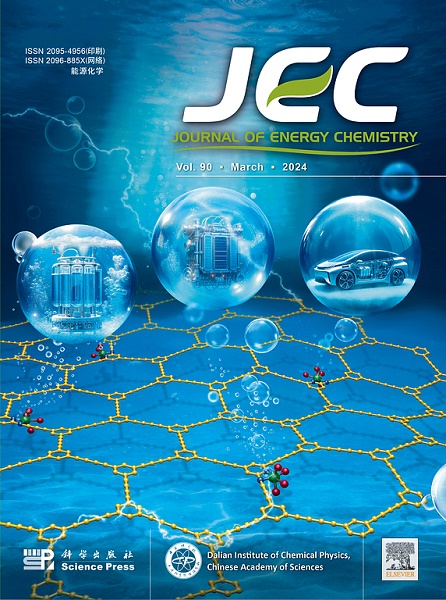Molecular docking-driven anion coordination enabling SEI engineering for ultrastable all-solid-state lithium metal batteries
IF 13.1
1区 化学
Q1 Energy
引用次数: 0
Abstract
Regulating lithium (Li) salt decomposition to construct a stable solid electrolyte interphase (SEI) represents a pivotal strategy for mitigating Li dendrite and unlocking the full potential of polymer-based all-solid-state Li metal batteries. However, this approach necessitates precise manipulation of the coordination chemistry and decomposition kinetics of Li-salt anions, which remains a formidable challenge in the field. Herein, we unveil a molecular docking-guided design framework that correlates the molecular topology of ligands with bis(trifluoromethanesulfonyl)imide (TFSI−) anion coordination chemistry in poly(ethylene oxide) (PEO)-based solid polymer electrolytes. Theoretical calculations and experimental investigations elucidate that short-chain dithiols (e.g., 1,2-ethanedithiol, C2) exhibit optimal spatial complementarity and superior molecular docking efficacy with TFSI− compared to long-chain analogues. Intermolecular hydrogen bonding redistributes electron density toward TFSI−, promoting its decomposition and enhancing LiF content in the SEI, thereby effectively suppressing Li dendrite growth. Consequently, the Li||LiFePO4 cells equipped with PEO-LiTFSI-C2 electrolyte achieve a remarkable 99.2% capacity retention after 580 cycles at 1.0 C, surpassing both long-chain dithiol systems and most previously reported electrolytes. This work provides mechanistic insights into the anion-coordination-mediated SEI formation process. Furthermore, the molecular docking is expected to play a significant role in understanding and researching the interfacial chemistry of all-solid-state Li metal batteries.

分子对接驱动的阴离子配位实现了超稳定全固态锂金属电池的SEI工程
调节锂盐分解以构建稳定的固体电解质界面(SEI)是减轻锂枝晶和释放聚合物基全固态锂金属电池全部潜力的关键策略。然而,这种方法需要精确地操纵锂盐阴离子的配位化学和分解动力学,这仍然是该领域的一个巨大挑战。在此,我们揭示了一个分子对接引导的设计框架,该框架将配体的分子拓扑与聚环氧乙烷(PEO)基固体聚合物电解质中的双(三氟甲烷磺酰)亚胺(TFSI -)阴离子配位化学联系起来。理论计算和实验研究表明,与长链类似物相比,短链二硫醇(如1,2-乙二硫醇,C2)与TFSI -具有最佳的空间互补性和优越的分子对接效率。分子间氢键将电子密度重新分配给TFSI−,促进其分解,提高SEI中LiF含量,从而有效抑制Li枝晶生长。因此,配备PEO-LiTFSI-C2电解质的Li||LiFePO4电池在1.0℃下580次循环后的容量保持率达到了99.2%,超过了长链二硫醇体系和大多数先前报道的电解质。这项工作为阴离子配位介导的SEI形成过程提供了机制见解。此外,分子对接有望在理解和研究全固态锂金属电池的界面化学方面发挥重要作用。
本文章由计算机程序翻译,如有差异,请以英文原文为准。
求助全文
约1分钟内获得全文
求助全文
来源期刊

Journal of Energy Chemistry
CHEMISTRY, APPLIED-CHEMISTRY, PHYSICAL
CiteScore
19.10
自引率
8.40%
发文量
3631
审稿时长
15 days
期刊介绍:
The Journal of Energy Chemistry, the official publication of Science Press and the Dalian Institute of Chemical Physics, Chinese Academy of Sciences, serves as a platform for reporting creative research and innovative applications in energy chemistry. It mainly reports on creative researches and innovative applications of chemical conversions of fossil energy, carbon dioxide, electrochemical energy and hydrogen energy, as well as the conversions of biomass and solar energy related with chemical issues to promote academic exchanges in the field of energy chemistry and to accelerate the exploration, research and development of energy science and technologies.
This journal focuses on original research papers covering various topics within energy chemistry worldwide, including:
Optimized utilization of fossil energy
Hydrogen energy
Conversion and storage of electrochemical energy
Capture, storage, and chemical conversion of carbon dioxide
Materials and nanotechnologies for energy conversion and storage
Chemistry in biomass conversion
Chemistry in the utilization of solar energy
 求助内容:
求助内容: 应助结果提醒方式:
应助结果提醒方式:


